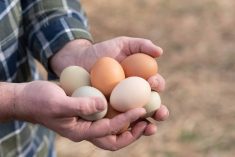Years ago I attended a public relations meeting on the topic of how companies and other organizations could influence government.
I was a web editor with Alberta Agriculture at the time and wasn’t really a bureaucrat that anyone was trying to influence, so I’ve forgotten details. But the gist of it was that you influenced government officials by building a relationship with them, by helping them when you can and by not flogging them in the media (or at least warning them first).
None of this is automatically sinister. Co-operation can be a good thing. But it did leave a bad taste in my mouth. It lay bare how government officials might disregard citizens’ best interests in favour of power.
Read Also

Gentle treatments for pain in the neck
Heading toward year-end, people unknowingly tense up against the cold and busyness, causing neck pain that can often be treated with appropriate support and gentle mobility, athletic therapist Kathlyn Hossack says.
I didn’t think about it at the time, but influence is a two-way street. Several farm groups were spotlighted in the Western Producer last spring for applauding the feds more often than debating issues.
But what is the right approach when dealing with government? Should farm groups co-operate, protest loudly, or find a middle ground?
Finding the right approach
I couldn’t think of a definitive answer, so I phoned Dr. David McGrane, a political scientist with the University of Saskatchewan. McGrane is also president of the Prairie Political Science Association.
“I don’t know if there’s one particular approach that works better than the other,” said McGrane. (“Darn it,” I thought). Both co-operative and adversarial approaches have worked over the years, and it’s up to farm groups to figure out which approach works best for them right now, he added.
Groups such as Greenpeace have successfully worked outside government, McGrane said, as governments are more environmentally-conscious than they once were.
But it’s not just environmental groups that turn to activism and civil disobedience. “Saskatchewan has a whole history of farm protests going back to the CCF and Tommy Douglas,” said McGrane.
You only need to look at the Canadian Wheat Board’s monopoly for more recent examples of farmers protesting. On the one hand, we have the Friends of the Canadian Wheat Board, who have turned to the courts to try to save the monopoly. On the other, we have Farmers for Justice, whose members tried to sink the single desk by dumping grain on the Wheat Board’s door step and serving time for crossing the border with grain.
There are also examples, which may be hard to find, of groups “quietly working with government” to achieve agreed-to goals, said McGrane. It’s hard to say that one tactic or the other will work 100 per cent of the time, he said.
At times, it’s “fair comment” to accuse a group of being “too cozy” with the government, McGrane said. For example, a more adversarial approach on the grain transportation file might have worked better for some farm groups, he said. However, going toe-to-toe with the feds didn’t work for the Friends of the Canadian Wheat Board.
“That group has been very much against the government, very openly, yet haven’t been able to stop what’s happened with the Wheat Board,” said McGrane.
Constantly taking shots at the government poses risks. But all farm groups, including those who favour more co-operation, need to make sure they put their members’ interests first. McGrane said he’s not sure if there’s a foolproof way of doing that.
Finding a balance
I think several farm groups have figured out this balance. For example, the Saskatchewan Stock Growers Association was quick to defend ranchers’ interests when the federal government issued an emergency protection order for the sage grouse in 2013. The Stock Growers have also applauded the feds for new trade deals. The Agricultural Producers Association of Saskatchewan (APAS) both praises and critiques the provincial government and has criticized the federal government’s handling of grain transportation.
These farm groups seem to know where they need to stand on various issues, and they’re not afraid to tell the rest of us where they’re at. By doing so, they’re holding governments accountable. They’re also adding to public discussions.
Ultimately, voters decide whether politicians — and farm leaders — are serving their interests. Membership response to the board’s direction is a good barometer of whether they’re truly representing those members, McGrane pointed out.
If farm leaders are too cozy with government, and the group has a democratic process, it’s up to members to have “a revolution of some sort, whether that be voting them out or pushing out their leaders in some other way,” said McGrane.
So whether or not being a government cheerleader, adversary, or something in between is the best approach for each farm group is debatable. In the end, farmers will get their say during the farm meeting season.
















